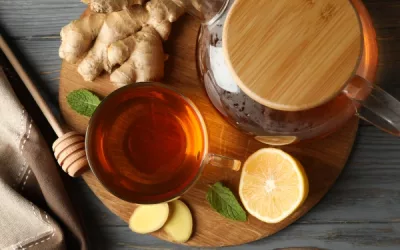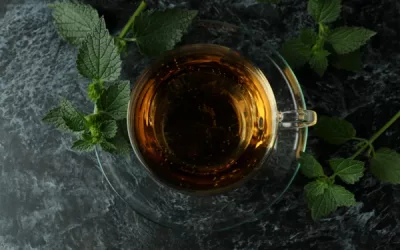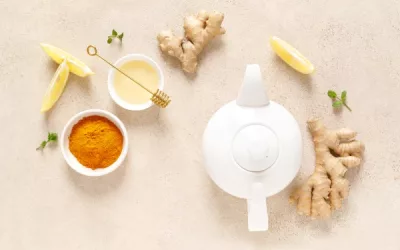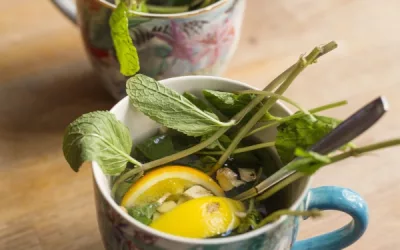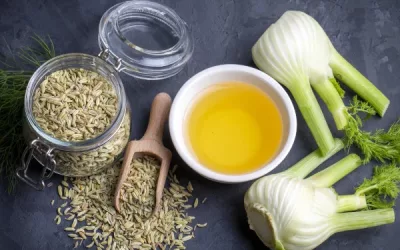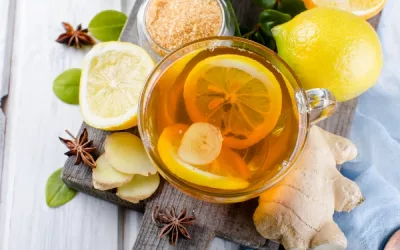Did you know that hibiscus tea has been cherished across cultures for centuries not just for its vivid colour but also for its remarkable health benefits? Whether you’re aiming to manage blood pressure or simply enjoy a refreshing beverage, this herbal tea holds incredible potential. In this ultimate guide, we’ll delve into the myriad health advantages of hibiscus tea, how to prepare it to perfection, its cultural significance, and much more, ensuring you have all the information to embrace this vibrant drink and enhance your well-being.
Table of Content
What is hibiscus tea?
Hibiscus tea is an herbal tea made from the dried petals of the hibiscus flower, known for its vibrant red color and tart, cranberry-like flavor. It’s a caffeine-free beverage commonly enjoyed both hot and cold.
The tea is popular in many cultures and regions, including Africa, the Middle East, and the Caribbean, where it’s often sweetened and served with a squeeze of lime. Rich in antioxidants, hibiscus tea is praised for its potential health benefits, such as lowering blood pressure and supporting heart health.
In addition to its health properties, hibiscus tea is valued for its refreshing and tangy taste, which makes it a versatile drink for any time of the day. It is often blended with other herbs or spices, such as ginger or mint, to enhance its flavor.
Hibiscus tea can also be used as a natural dye due to its deep red hue. Its distinct taste and potential health benefits make it a favorite among tea enthusiasts and health-conscious consumers alike.
How can you ensure the freshness of hibiscus tea?
Nothing kills the joy of tea like stale petals. Follow these tips to keep it fresh as a daisy, or in this case, a hibiscus.
Finding quality hibiscus tea is a bit like finding the perfect pair of shoes—comfort and quality matter a lot. To get your hands on some top-notch hibiscus tea, you’ll want to explore a mix of online retailers and local markets. And no, your neighbour’s rose bush won’t cut it!
- Storage: Keep them in an airtight container. Exposure to air is like a death sentence for freshness.
- Light: UV rays do more than just tan your skin; they degrade tea too. Store it in a dark cupboard.
- Temperature: Room temperature is your friend. Keep it cool, but not cold.
- Buy in Small Quantities: Just because Costco has a 5kg bag of hibiscus doesn’t mean you should buy it. Smaller quantities ensure you drink it before it loses its zest.
- Check Expiry Dates: Obvious but often overlooked. Fresh stock equals fresh tea.
Proper storage and mindful purchasing not only lengthen shelf life but continue to deliver that vibrant, tart flavour you love.
How do you prepare hibiscus tea effectively?
Hibiscus tea is a delightful herbal infusion made from the dried petals of the hibiscus flower. The process of preparing hibiscus tea can be simple, but to get the best flavour and strength, you need to follow specific methods. Let’s dig into various preparation methods and explore ways to enhance your tea experience.
To help you understand the different preparation methods, I’ve put together a table that breaks down the steeping times and serving suggestions. Each row represents a different method, offering you a variety of ways to enjoy this refreshing beverage.
| Preparation Method | Steeping Time | Serving Suggestion |
|---|---|---|
| Hot Brew (Traditional) | 5-10 minutes | Serve hot with a slice of lemon |
| Cold Brew | 8-12 hours | Serve chilled over ice |
| Sun Tea | 3-4 hours | Garnish with mint leaves |
| Concentrate | 30 minutes | Dilute with cold water |
| Quick Brew (Boiling) | 5 minutes | Add honey and cinnamon stick |
| Blended with Fruit | 10 minutes | Serve with fresh fruit chunks |
| Spiced Hibiscus Tea | 10-15 minutes | Add ginger and cloves |
Using this table is straightforward. Pick the preparation method that suits your mood or occasion, note the steeping time, and follow the serving suggestion for an enhanced flavour experience.
What are the health benefits of hibiscus tea?
Hibiscus tea is not only delicious but also packed with health benefits. It’s been a part of traditional medicine for centuries, known for its vibrant colour and tart flavour.
Some health benefits of hibiscus tea include:
- Lowers blood pressure
- Rich in antioxidants
- Supports liver health
- Aids in weight loss
- Boosts the immune system
Its deep red hue is a sign of its high antioxidant content, which helps combat oxidative stress in the body. Studies have shown that regularly drinking hibiscus tea can help maintain a healthy blood pressure level, making it a great addition for those looking to support their heart health.
What are the different flavours and variations of hibiscus tea?
Hibiscus tea is incredibly versatile and can be paired with various flavours to create unique blends. Each variation offers a different taste experience, catering to diverse palates.
Popular flavour combinations include:
- Hibiscus and mint
- Hibiscus and ginger
- Hibiscus and citrus
- Hibiscus and berries
- Hibiscus and cinnamon
These variations can be achieved by adding fresh herbs, spices, or fruit slices during the steeping process. For instance, adding fresh mint leaves to your hibiscus tea can provide a refreshing twist, while a piece of ginger can introduce a warm, spicy note.
In the 18th century, Captain James Cook, the British explorer, came across hibiscus tea during his travels to the Pacific Islands. The indigenous people used the vibrant petals to create a refreshing drink that intrigued Cook and his crew.
They found it revitalising during their long journeys and brought the concept back to Europe, where it became a curiosity among herbal tea enthusiasts.
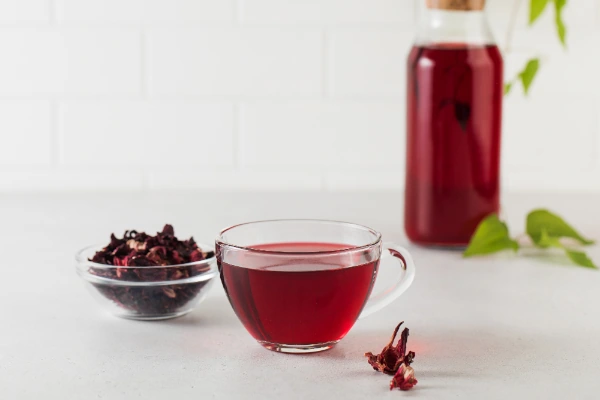
Are there any side effects of drinking hibiscus tea?
So, you’re sitting there sipping on your hibiscus tea, feeling all sorts of herbal wellness. But wait, are there any side effects to guzzling this magenta elixir? Short answer: Yes, but they’re mostly minor and only affect a small group of people. Let’s dig into it.
So, hibiscus tea, not just a fancy drink to impress guests with its vibrant colour, can also have a few potential side effects. Most people might not experience any, but if you’re the unlucky one, here’s what you need to look out for:
- Interactions with Medications: If you’re already on prescription drugs for things like high blood pressure, diabetes, or any antidepressants, proceed with caution. Hibiscus tea has a reputation for lowering blood pressure, nice in theory, but not if you’re already on meds aiming for the same goal.
- Effects on Blood Pressure: Speaking of blood pressure, hibiscus tea is basically the Houdini of lowering it. A bit too effective sometimes, it might drop your pressure to a level where you’re not feeling all that great. Dizzy spells, anyone?
- Allergic Reactions: Sneezing, itching, or hives after drinking the tea could mean that this beverage doesn’t love you back as much as you love it. Allergies to hibiscus are rare but not impossible.
You get the picture, but let’s zoom in on who should really give hibiscus tea a wide berth.
Who should avoid hibiscus tea?
Wondering if you’re on the hibiscus blacklist? Well, check this out:
- Pregnant women, because you don’t want to mess with those hormones.
- People with low blood pressure, given the tea’s superpower in lowering blood pressure.
- Those taking medications for diabetes or hypertension.
Simple as that. Basically, if any of these red flags start waving in your face, maybe swap that hibiscus for a simple chamomile.
What are the signs of an allergic reaction to hibiscus?
No tea is worth a trip to the A&E. If hibiscus tea gives you any grief in the form of an allergic reaction, here’s what to watch out for:
- Itchy throat or mouth: Like you accidentally gnawed on a fibre-optic Christmas tree.
- Hives or rash: Your skin could break out into patterns usually reserved for avant-garde art shows.
- Swollen lips or tongue: Suddenly looking like you tried and failed a Kylie Jenner lip challenge.
- Difficulty breathing: Basically your body’s SOS signal.
If any of these reactions occur, put the cup down and back away slowly—better safe than sorry.
How does hibiscus tea interact with common medications?
This tea is not on good terms with a few medications, so keep that in mind:
- Antihypertensives: Both are trying to lower your blood pressure. Teaming them up could drop it too much.
- Diabetes meds: Hibiscus tea can affect blood sugar levels. If they’re already being controlled by meds, watch out.
- Antidepressants: It specifically messes with tricyclic antidepressants, potentially enhancing its effects to unwanted levels.
Always smart to chat with your doc if you don’t want your daily cuppa to turn into a disruption for your medication routine.
Back in the day, Cleopatra is said to have drunk hibiscus tea (or a variation of it) for its beauty benefits, but it likely deflated her as much as it uplifted her due to its effects on blood pressure.
So, while she claimed to embody the essence of beauty and grace, she might have also had a spell or two of dizziness—making her legendary walks a tad wobbly! If it can happen to the Queen of the Nile, it can happen to you. Keep your hibiscus game strong but smart.
What Is The Cultural Significance Of Hibiscus Tea?
Ah, hibiscus tea, the crimson elixir that has charmed its way into cups around the globe. Whether you’re sipping it hot to warm your soul or cold to cool off during a summer day, hibiscus tea carries with it a rich tapestry of cultural significance that spans generations and continents.
From its historical uses, which date back to ancient Egypt where pharaohs apparently thought it was the nectar of the gods, to modern times where it’s embraced by health nuts and herbal aficionados, hibiscus tea has always been a star performer.
We’re talking about a drink that has seen it all—from lavish royal ceremonies to your grandma’s kitchen. And let’s not forget its vibrant colour, making it the life of every teapot party it graces.
Now, let’s delve deeper into how this delightful brew has woven itself into the cultural fabric of different societies.
How Is Hibiscus Tea Consumed In Different Cultures?
Every day, hibiscus tea finds itself infused into the traditions and customs of various cultures. Here’s a quick tour around the world:
- Egypt: Known as “Karkade,” it’s a national treasure. Consumed during hot weather to beat the heat, it’s also a key player in weddings and celebrations.
- Mexico: Here, it’s all about “Agua de Jamaica,” a sweet, refreshing drink often served in large pitchers at family gatherings.
- Sudan: People drink it during special occasions, and it’s believed to lower blood pressure. Sweetened with sugar, it’s a staple of hospitality.
- Thailand: Known for its vibrant street food culture, hibiscus tea is available as a chilled, tangy refreshment.
- Caribbean: It’s called “Sorrel” around Christmas time. Combined with spices like cinnamon and cloves, it’s your festive sip with a zing.
Now, while these are just a handful of examples, the way people enjoy hibiscus tea varies as widely as the regions themselves. It’s a connector, a unifier, and let’s face it—pretty darn tasty too.
What Are Some Traditional Recipes Involving Hibiscus Tea?
Not only does hibiscus tea come bursting with flavour, but it’s also a flexible ingredient that adds a twist to many traditional recipes:
- Agua de Jamaica (Mexico): Hibiscus petals, water, sugar, and a squeeze of lime. Imagine this chilled on a hot summer day—pure bliss.
- Caribbean Sorrel Punch: Hibiscus petals, ginger, cloves, cinnamon, sugar, and rum for those looking to spice things up.
- Sudanese Karkade: Hibiscus petals, sugar, and lots of patience as it’s steeped to perfection. Served chilled to keep that Saharan heat in check.
- Jamaican Sorrel Cake: Fancy a dessert? This cake involves hibiscus syrup, which adds a floral tanginess to the mix.
- Thai Hibiscus Juice: Fresh hibiscus petals, a bit of sugar, and a pinch of salt elevate this tart delight to new heights.
These recipes highlight how hibiscus tea isn’t just a beverage but a crucial part of culinary traditions worldwide. So, next time you’re brewing a cup, why not get creative and try out one of these?
Why Is Hibiscus Tea Important In Social Gatherings?
Life is full of moments better shared with someone else, and what better way to do that than over a cup of hibiscus tea? This beverage isn’t just a thirst-quencher; it’s a social glue.
- Symbolism: In many cultures, offering hibiscus tea is a sign of hospitality and respect.
- Celebrations: It plays a crucial role in weddings, festivals, and holiday feasts, adding a pop of colour and a splash of flavour.
- Conversation Starter: Its unique taste and vibrant look make it a perfect conversation piece.
- Health Benefits: Supports wellness discussions—people love talking about its benefits like lowering blood pressure and aiding digestion.
- Regional Pride: Each culture has its own spin on hibiscus tea, adding an element of local identity and pride.
Gathering over hibiscus tea transforms simple meetings into memorable moments. Plus, it’s always fun to share the origin stories and see eyes light up when someone tries it for the first time.
Let me hit you with a historical tidbit: In ancient Egypt, hibiscus tea was considered so valuable that it was often served to pharaohs. Legend has it that Cleopatra herself indulged in this ruby-red delight, believing it had rejuvenating properties.
It’s also said that hibiscus petals were used in the mummification process due to their healing properties. Talk about a beverage fit for royalty!
So the next time you raise a glass of hibiscus tea, know you’re partaking in a tradition that stretches back millennia. Enjoy every sip, and maybe throw in a fun fact or two to impress your friends!
What are the best ways to consume hibiscus tea?
Alright, health junkie! You want to know how to best enjoy your hibiscus tea, right? Let’s dive straight into it. You can sip this ruby-coloured elixir hot or cold, mix it up with other ingredients, and even incorporate it into recipes that make your taste buds sing.
So, buckle up as we explore the ways to drink, mix, and cook with hibiscus tea.
Now, when we’re talking about enjoying hibiscus tea, we’re really spoiled for choice. Let’s break it down:
- Hot vs Cold: In the winter, a hot cup of hibiscus tea can be like a cosy blanket for your soul. Its tangy, tart flavour will warm you up from the inside out. Flip the switch to summer and you’ve got yourself a refreshing, iced beverage that beats the heat. Add a slice of lemon or mint leaves for extra zing.
- Mixing it up: Why stop at just tea? Blend it with other herbal teas like ginger or chamomile for a tailor-made concoction. You can also sweeten things up with a dash of honey or agave syrup. Love experimenting? Try adding fruit slices, such as oranges or berries, for a natural flavour boost.
- Incorporate it into recipes: Hibiscus isn’t just for sipping. You can use it to make syrups for pancakes or cocktails, jam for toast, or even as a marinade for meats. The tartness of hibiscus adds depth and a splash of colour. Get creative in the kitchen, and you’ll be wondering why you didn’t start using it earlier.
Can hibiscus tea be used in cocktails?
You bet your shaker it can! Who says your hibiscus tea can only be enjoyed in a teacup? Turn it into a cocktail to make your gatherings more colourful and flavourful. Instead of plain cocktails that everyone’s bored of, why not surprise your guests with something unique?
- Hibiscus Margarita: Margarita with a twist, anyone? Mix your classic margarita ingredients with hibiscus tea for a tangy kick.
- Hibiscus Mojito: Imagine the freshness of a mojito but with an added floral note. Blend your mint, lime, and rum with some iced hibiscus tea.
- Hibiscus Sangria: Elevate your sangria game by adding hibiscus tea to your wine and fruit mix. It not only tastes divine but looks fantastic too.
- Hibiscus Gin & Tonic: A simple but stunning combination. Add some hibiscus tea to your gin and tonic for a more vibrant experience.
- Hibiscus Mule: Moscow mule’s cooler cousin. Swap out some ginger beer with hibiscus tea for that punch of colour and taste.
Nothing says “I’m a fancy adult” like serving cocktails with a health-conscious twist, does it? Plus, it’s a great conversation starter.
What are some popular flavour pairings with hibiscus tea?
Hibiscus tea is a flavour chameleon. It pairs well with a myriad of other flavours, making it incredibly versatile. You can go from tart and tangy to sweet and spicy just by changing what you mix it with.
- Citrus Flavours: Lemon, orange, and lime enhance hibiscus’s natural tanginess.
- Herbs: Mint and basil can add freshness, while ginger adds a spicy undertone.
- Spices: A hint of cinnamon or clove can turn your tea into an aromatic delight.
- Berries: Blueberries, raspberries, and strawberries complement the tartness beautifully.
- Sweeteners: Honey, agave, and even vanilla bring out hibiscus’s inherent floral notes.
These combinations can elevate your simple tea into something special. Experiment with what tickles your taste buds!
How can hibiscus tea be incorporated into a daily diet?
Drinking hibiscus tea is like giving your daily routine a flavourful and healthy upgrade. You can easily work it into various meals and snacks.
- Morning Ritual: Swap out your morning coffee for a hot cup of hibiscus tea. It’s packed with antioxidants and caffeine-free.
- Smoothie Boost: Throw in some chilled hibiscus tea into your blender along with your favourite fruits for a vibrant smoothie.
- Snack Time: Use hibiscus tea to make fruit popsicles, or drizzle hibiscus syrup over yoghurt.
- Cooking: Use hibiscus tea as a base for cooking grains like quinoa or rice. It adds a subtle tang and a lovely colour.
- Dinner: Marinate your chicken or tofu in hibiscus tea mixed with spices for a tangy twist.
- Dessert: Bake hibiscus tea-infused cakes or cookies for a fragrant, unique flavour.
Consuming hibiscus tea isn’t just about drinking; it’s about incorporating its health benefits into your everyday life!
Back in the 18th century, hibiscus tea was a luxury in Europe, known as ‘Red Sorrel’ by the early British settlers in Jamaica. It wasn’t just a drink but a status symbol among the wealthy.
Fast forward to 1772 when Captain James Cook, that seafaring explorer we’ve all read about, took some hibiscus plants from the Caribbean to Australia. He’s the same dude who mapped the Pacific, by the way.
So, the next time you sip your hibiscus tea, remember, you’re sipping on something with quite the worldly heritage.
How does hibiscus tea compare to other herbal teas?
Alright, let’s dive straight into the gustatory garden and find out what makes hibiscus tea stand out from the rest. There’s a crowd of herbal teas out there, from chamomile giving you those snooze-inducing vibes to minty-fresh peppermint tea. Here’s how our star player, hibiscus tea, measures up in this herbal showdown.
What are the unique properties of hibiscus tea compared to chamomile?
Imagine hibiscus tea and chamomile having a tea party. Hibiscus tea, with its bold red colour and tart, cranberry-like flavour, is like that extroverted friend who always brings the zing to any gathering. Chamomile, on the other hand, is like the mellow buddy who turns up with a cosy blanket and pyjamas, offering a mild, apple-like taste.
Unique properties:
- Flavour:
- Hibiscus: Tart, tangy, and vibrant. It’s a wake-up punch in a mug.
- Chamomile: Gentle, calming, and slightly sweet. Perfect for winding down.
- Colour:
- Hibiscus: Deep red, from anthocyanins.
- Chamomile: Light yellow, thanks to flavonoids.
- Health Benefits:
- Hibiscus: Helps lower blood pressure, high in Vitamin C, and may support weight loss.
- Chamomile: Boosts sleep quality, eases digestion, and has anti-inflammatory properties.
- Attributes:
- Hibiscus: Tropical, refreshing, and versatile in both hot and cold brews.
- Chamomile: Relaxing, soothing, and a classic bedtime ally.
So, while chamomile is great for bedtime, hibiscus packs a zesty punch that makes it perfect for any time of day you need a pick-me-up.
How does hibiscus tea’s antioxidant content compare to green tea?
Now, let’s get into the nitty-gritty of antioxidants. Both hibiscus tea and green tea have loyal fan bases, and they are both powerhouses of health benefits. But if you’re curious about who wins the antioxidant battle, grab your mug and keep reading.
Antioxidant content:
- Hibiscus Tea:
- Rich in anthocyanins, which give it that ruby-red hue.
- Contains flavonoids and phenolic acids.
- Strong antioxidant activity that fights free radicals.
- Green Tea:
- Packed with catechins, especially epigallocatechin gallate (EGCG).
- High in polyphenols which act as antioxidants.
- Known for its cancer-fighting and heart-health benefits.
Hibiscus tea often parades its strong antioxidant properties, similar to but slightly less renowned than those in green tea. While green tea is the seasoned warrior in the antioxidant arena, hibiscus gives a compelling fight with its own health-boosting power.
What are the main differences in preparation between hibiscus and peppermint tea?
Let’s get down to the nitty-gritty of making these teas, because you wouldn’t want to ruin a good cup of yours truly, would you?
Preparation differences:
- Temperature:
- Hibiscus: Boil water to around 100°C (think hot like your morning shower).
- Peppermint: Use water slightly below boiling (85-90°C) to preserve the minty freshness.
- Steeping Time:
- Hibiscus: Steep 5-10 minutes for that deep red infusion.
- Peppermint: Steep 7-10 minutes to get a perfect concoction.
- Parts Used:
- Hibiscus: Dried flower petals.
- Peppermint: Dried or fresh leaves.
- Served:
- Hibiscus: Can be served hot or iced, and often sweetened or with a splash of lime.
- Peppermint: Usually enjoyed hot, and can be combined with other herbs.
Hibiscus tea is all about that flexible and adaptable vibe – hot or cold, it’s ready to roll with your culinary whims. Peppermint, however, stays classic and refreshing, holding its aromatic presence with dignity.
Back in ancient Egypt, hibiscus tea was the famous brew among Pharaohs. It was often served cold to combat the sweltering heat of the Egyptian sun. Cleopatra herself was said to indulge in this vibrant tea to maintain her legendary beauty and vitality.
That’s right, folks, even in antiquity, hibiscus tea was making waves and keeping rulers refreshed and radiant. So next time you sip on some hibiscus tea, remember you’re partaking in a royal tradition!
Conclusion
As I reflect on the myriad of benefits and cultural significance surrounding hibiscus tea, it’s clear that this vibrant beverage deserves a prominent place in our diets. From its antioxidant properties that shield our bodies from oxidative stress, to its potential role in lowering blood pressure and aiding in weight management, hibiscus tea presents a compelling case for its health benefits. The nuances of preparation—from steeping times to serving suggestions—allow us to tailor our experience, ensuring that each sip is not only enjoyable but also maximally beneficial.
What stands out, however, is the rich cultural history of hibiscus tea, transcending regions and traditions. In various communities, it’s not just a drink; it is an integral part of social gatherings and ceremonies, symbolising hospitality and connection. As we immerse ourselves in these practices, we find that hibiscus tea brings people together, celebrating both heritage and wellness.
Yet, while advocating for hibiscus tea, I also encourage mindful consumption—being aware of potential side effects and contraindications, especially regarding interactions with medications or in cases of allergies. It’s always wise to consult with a healthcare provider when introducing new elements to your health regimen.
Looking ahead, I invite you to explore various ways to incorporate hibiscus tea into your daily life, whether through refreshing cocktails or hearty recipes. What blends and creations can you come up with? And as we continue to advance our understanding of herbal teas, let us seek further research into their properties, shedding light on benefits we have yet to fully uncover.
Ultimately, as I sip on my cup of hibiscus tea, I am reminded of its deeper meaning and the well-being it fosters. In the words of a beloved saying, “Let food be thy medicine, and medicine be thy food.” So, let hibiscus tea be both—a delicious indulgence and a nurturer of health. What will you make of it in your own life?
Resources
- A review of the effectiveness of hibiscus for treatment of metabolic syndrome
- Hibiscus sabdariffa L. in the treatment of hypertension and hyperlipidemia: a comprehensive review of animal and human studies
- Physiological Effects and Human Health Benefits of Hibiscus sabdariffa: A Review of Clinical Trials
- Hibiscus Sabdariffa L. Tea (Tisane) Lowers Blood Pressure in Prehypertensive and Mildly Hypertensive Adults
- A systematic review and meta-analysis of the effects of Hibiscus sabdariffa on blood pressure and cardiometabolic markers
- Hibiscus tea and health: A scoping review of scientific evidence


